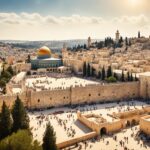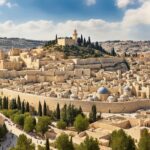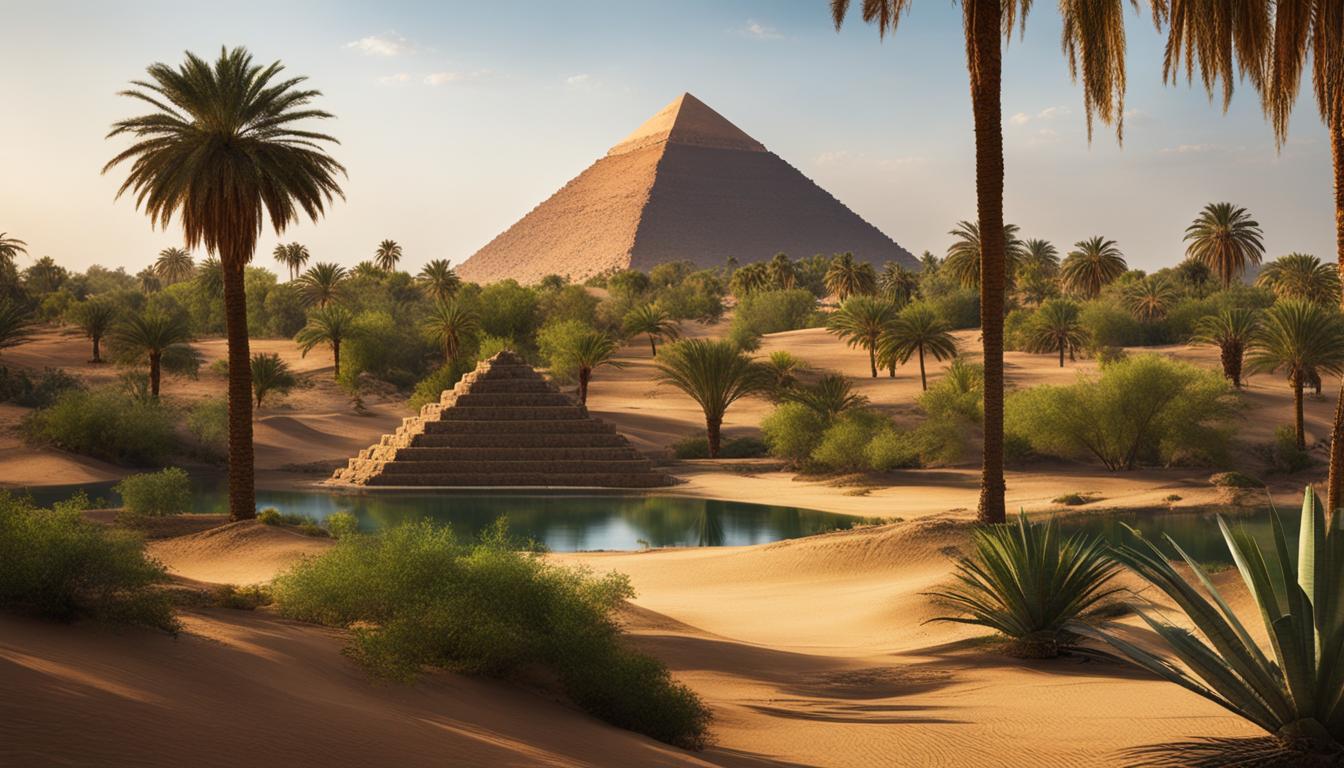Welcome to our exploration of Jerusalem in the time of Jesus. This ancient city holds a significant place in history, not only as the birthplace of Jesus but also as a sacred site for Christian pilgrimage. Let us delve into the rich history of Jerusalem, uncovering its role in biblical events and its enduring importance as a center of religious tourism in the Holy Land.
During the time of Jesus, Jerusalem was part of the Roman Empire and governed by a complex system of client kings, governors, and local leaders. Herod the Great, a notable figure, ruled over Jewish Palestine, including Jerusalem, as a “friend and ally” of Rome. The city’s history and culture were deeply intertwined with religious significance, making it a gateway to the spiritual world for believers from near and far.
Key Takeaways:
- Jerusalem, the city of Jesus’ birth, holds immense historical and religious significance.
- It is a popular destination for Christian pilgrims, drawn to its many biblical sites.
- During Jesus’ time, Jerusalem was under Roman rule and governed by various leaders.
- The city played a pivotal role in the life of Jesus, from his birth to his crucifixion.
- Understanding the historical and cultural context of Jerusalem enhances our understanding of Jesus’ teachings.
Political Situation
Palestine, located between Syria and Egypt, held significant importance within the vast Roman Empire. The Roman Empire exercised its authority over Palestine through a system of client kings and governors. During the time of Jesus, the ruler of Jewish Palestine was Herod the Great, who maintained a close alliance with Rome as a “friend and ally” king. However, following Herod’s demise, his kingdom was divided among his sons. Roman prefects, such as Pontius Pilate, were appointed to govern specific regions on behalf of the empire.
The political structure in Palestine during Jesus’ time showcased the intricate dynamics between Rome and its client kings, demonstrating the Empire’s control and influence over the region. Let’s delve deeper into the key players and governing authorities:
Client Kings and Governors
As a part of the Roman Empire, Palestine was administered through the appointment of client kings or governors. These rulers acted as intermediaries, executing Rome’s directives and maintaining relative order and stability within their respective territories. The client kings and governors were responsible for governing and handling local affairs, while still maintaining allegiance to Rome.
Herod the Great: Friend and Ally
Herod the Great played a significant role in the political landscape of Jewish Palestine during Jesus’ time. He ruled the region as a “friend and ally” of Rome. Herod’s close ties with the Roman Empire ensured his position as the ruler of Jewish Palestine, granting him a certain level of autonomy to govern. His reign marked a time of relative stability and economic prosperity in the region.
The Prefect: Pontius Pilate
Pontius Pilate, appointed as the prefect by the Roman Empire, held the crucial position of governing Jerusalem. As a representative of Rome, Pilate was tasked with maintaining order, enforcing laws, and collecting taxes in the region. While he governed Jerusalem, Pilate relied on the support and advice of local leaders to navigate the complexities of daily governance.
“Rome ruled Palestine through client kings or governors, maintaining control over the region.”
| Rulers | Territories |
|---|---|
| Herod Archelaus | Judaea and Idumaea |
| Herod Antipas | Galilee |
| Pontius Pilate | Jerusalem |
The table above provides an overview of the territories ruled by different leaders during Jesus’ time, illustrating the division of power within Jewish Palestine.
Jewish-Gentile Relations
In the time of Jesus, the region of Palestine was characterized by distinct Jewish and Gentile areas. The main Jewish areas were Galilee and Judaea, surrounded by neighboring Gentile territories. Despite this geographical division, there was a certain level of interchange between Jewish and Gentile areas, particularly in terms of trade and the exchange of populations.
However, these Jewish-Gentile relations were often marked by tension and unease, which led to the separation and separate governance of Jewish and Gentile areas. The society of the time placed great importance on racial purity, resulting in the exclusion of Greek and Roman worship and institutions in Jewish cities.
This emphasis on racial purity reflected the deep-rooted social and cultural distinctions between Jews and Gentiles. The Jewish community sought to maintain their religious and ethnic identity, often regarding interactions with Gentiles with caution and suspicion.
“The society was deeply concerned with racial purity, resulting in the exclusion of Greek and Roman worship and institutions in Jewish cities.”
Galilee and Judaea: The Main Jewish Areas
Galilee and Judaea were the heartlands of Jewish life in Palestine. Galilee, located in the north, was known for its fertile lands and thriving agricultural economy, with towns such as Capernaum and Nazareth. Judaea, situated in the south, encompassed Jerusalem, the religious and political center of Jewish life.
Jewish-Gentile Interchange
Despite the divisions between Jewish and Gentile areas, there were instances of interchange between the two groups. Merchants, traders, and travelers moved between regions, bringing goods and cultural influences. Additionally, there were instances of population exchange, with some Gentiles settling in Jewish areas and vice versa.
This interchange fostered a certain level of cultural exchange and exposure to different perspectives. However, it also magnified the societal tensions and concerns related to maintaining racial purity. The Jewish community held steadfast to their religious and cultural traditions.
“The society was deeply concerned with racial purity, resulting in the exclusion of Greek and Roman worship and institutions in Jewish cities.”
| Jewish Areas | Gentile Areas |
|---|---|
| Galilee | Surrounded by neighboring Gentile territories |
| Judaea | Located in the south, encompassing Jerusalem |
Economic Conditions
During the time of Jesus, the economic conditions for most Palestinian Jews were centered around farming and herding. These occupations provided a means for them to support their families and fulfill their financial obligations, including paying taxes. The region of Galilee, in particular, enjoyed relative prosperity due to its fertile land and abundant harvests, as well as its support for a thriving sheep industry.
While there were some landless individuals and pockets of poverty, desperate poverty was not as prevalent or socially dangerous as in other areas. The social classes in Palestinian Jewish society were not sharply divided, and although there was a gap between the rich and the poor, it was not exceptionally wide compared to other parts of the world.
Understanding the economic conditions of the time helps us gain insight into the social dynamics and daily lives of the people who lived in this historical context.
“The economic conditions for most Palestinian Jews revolved around farming and herding, providing stability and sustenance for their families.” – Joachim Jeremias
Socio-economic Snapshot of Palestinian Jews
| Social Class | Occupation | Economic Condition |
|---|---|---|
| Poor | Landless | Struggling to meet basic needs, but not socially dangerous |
| Middle | Farmers, herdsmen | Earn enough to support families and pay taxes |
| Wealthy | Landowners, merchants | Enjoying relative affluence |
As this table illustrates, while poverty existed, the majority of Palestinian Jews were able to sustain themselves through their agricultural and herding occupations. The economic conditions were not characterized by extreme disparities or widespread destitution.
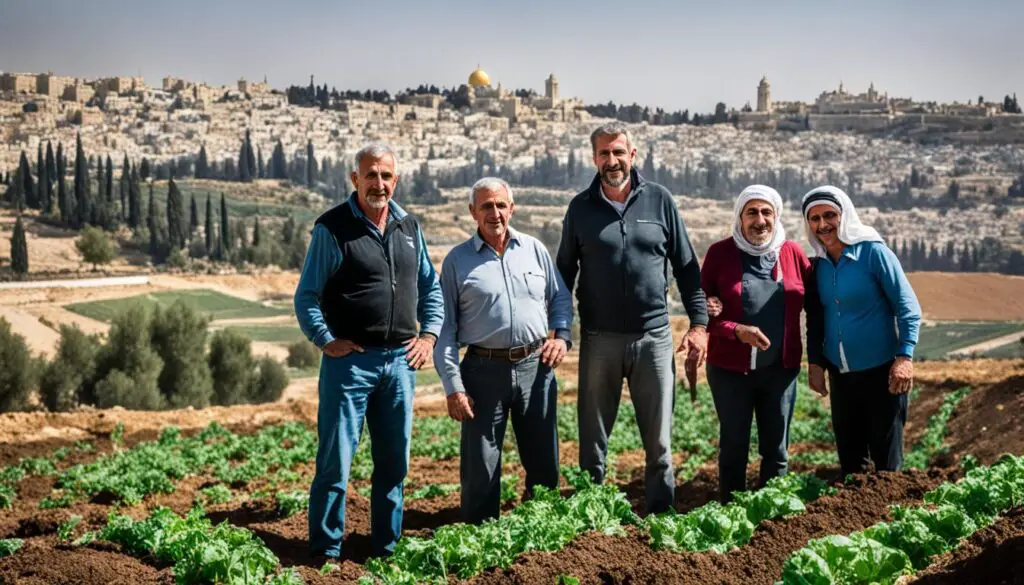
Jesus and Jerusalem in the Scriptures
The Scriptures provide valuable insights into the relationship between Jesus and Jerusalem during his time. One significant event mentioned in the Scriptures is Jesus staying in Bethany, a small village near Jerusalem, where Mary, Martha, and Lazarus lived.
During the Passion Week, Jesus made a triumphal entry into Jerusalem. This momentous occasion is mentioned in the Gospels of Matthew, Mark, Luke, and John, highlighting the significance of Jesus’ arrival in the holy city.
“Hosanna to the Son of David! Blessed is he who comes in the name of the Lord! Hosanna in the highest!” – Matthew 21:9
The Temple Mount in Jerusalem held immense religious and historical significance. It was the location of the Jewish temple, where devout Jews worshipped and offered sacrifices. King Herod, during the time of Jesus, initiated an ambitious project to expand and beautify the temple, known as the Temple Mount.
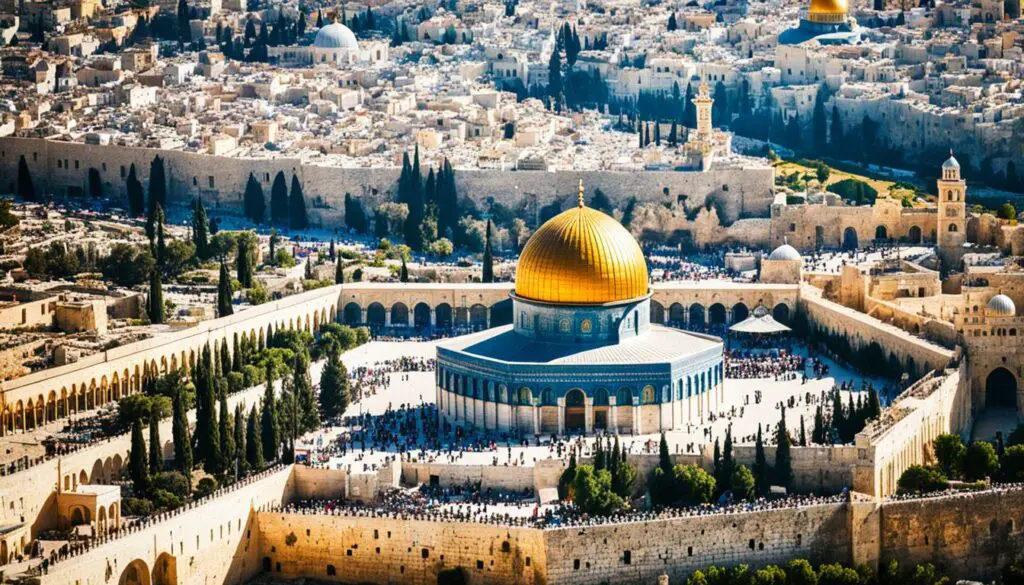
Unfortunately, the temple and all the magnificent buildings on the Temple Mount were destroyed by the Romans in 70 A.D., leaving the city in ruins and altering its landscape forever.
Jesus in Bethany: A Place of Friendship and Respite
Jesus had a close relationship with the people of Bethany, where he found solace and friendship. This small village located on the eastern slope of the Mount of Olives offered a peaceful retreat for Jesus during his ministry.
In Bethany, Jesus experienced intimate moments with his friends, Mary, Martha, and Lazarus. Their home became a place of warmth, hospitality, and spiritual nourishment. Jesus often visited their house, teaching and sharing meals with them.
Triumphal Entry: An Event of Prophetic Significance
The triumphal entry into Jerusalem was a pivotal event in Jesus’ ministry. It fulfilled various prophecies, including the messianic prophecy in Zechariah 9:9:
“Rejoice greatly, Daughter Zion! Shout, Daughter Jerusalem! See, your king comes to you, righteous and victorious, lowly and riding on a donkey, on a colt, the foal of a donkey.”
As Jesus entered Jerusalem, riding on a donkey, the people hailed him as the Son of David, welcoming him with shouts of joy and laying palm branches on the road.
| Key Events in Jesus’ Interaction with Jerusalem | Scripture References |
|---|---|
| Jesus stays in Bethany | Luke 24:50-53, John 11:1-12:11 |
| Triumphal entry into Jerusalem | Matthew 21:1-11, Mark 11:1-11, Luke 19:28-44, John 12:12-19 |
| Expanding the Temple Mount | Matthew 24:1-2, Mark 13:1-2, Luke 21:5-6 |
| Roman destruction of the temple | Matthew 23:37-24:2, Mark 13:1-2, Luke 21:5-6 |
Jerusalem in the Time of Jesus Infographic
Explore Jerusalem during the time of Jesus with these captivating infographics. Gain a visual representation of the city, as well as the important locations and events mentioned in the Scriptures.
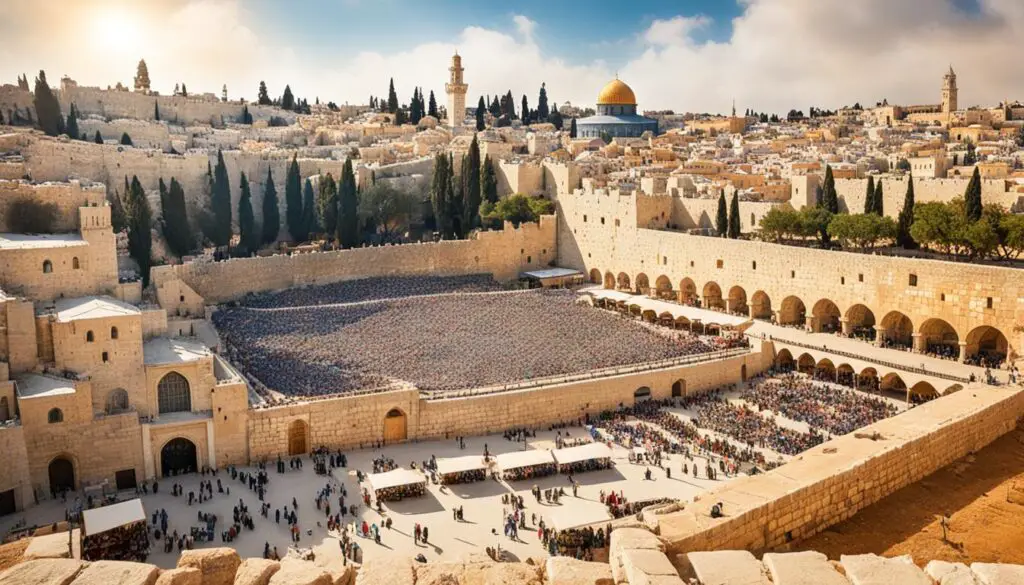
Map of Jerusalem
Immerse yourself in the geographical context of Jesus’ time with this detailed map of Jerusalem. Discover the location of Bethany, the village where Mary, Martha, and Lazarus lived, and trace the route of Jesus’ triumphal entry into Jerusalem. The map also highlights other areas mentioned in the Scriptures, giving you a comprehensive understanding of the city’s layout during that era.
Temple Mount and the Jewish Temple
Delve into the significance of the Temple Mount, the focal point of Jewish religious life during Jesus’ time. This infographic depicts the grandeur of the Jewish temple, which underwent expansion under King Herod’s rule. Marvel at the architectural marvel and gain insight into its importance in the life and teachings of Jesus. Sadly, the temple and all structures on the Temple Mount were later destroyed by the Romans, forever altering the landscape of Jerusalem.
Descriptive Treatment of Jerusalem
In his book on Jerusalem during the time of Jesus, German New Testament scholar Joachim Jeremias provides a comprehensive and descriptive treatment of the city. Jeremias explores the socio-economic and cultural background of ancient Palestine, shedding light on the world in which Jesus lived and taught. His work draws from various ancient sources, including the Talmud, Josephus, and Roman records, as well as archaeological evidence.
“Jerusalem during the time of Jesus was a vibrant city, with a rich socio-economic and cultural tapestry. By dissecting the ancient sources and examining archaeological findings, Jeremias uncovers valuable insights into daily life, religious practices, and customs of the period. This descriptive treatment of Jerusalem provides a deeper understanding of the New Testament and the historical context surrounding Jesus.”
Jeremias’ meticulous research has made his work a valuable resource for scholars and researchers interested in ancient Palestine. His book, available at the Library of Congress, offers a meticulous exploration of Jerusalem’s past, delving into the socio-economic factors, cultural nuances, and historical events that shaped the city during Jesus’ time.
To visualize the world of Jesus more vividly, take a look at the infographic depicting Jerusalem’s landscape and the Temple Mount, showcasing the architectural wonder at the center of Jewish life.
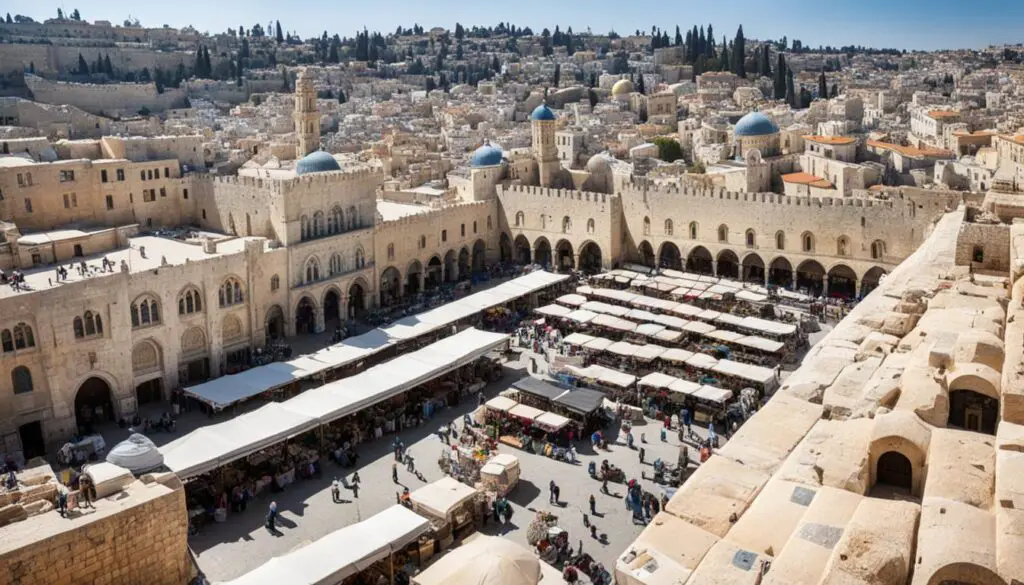
A Glimpse into Jerusalem’s Ancient Past
Diving into ancient sources, Jeremias pieces together a comprehensive picture of Jerusalem’s socio-economic background. By examining the cultural elements that influenced daily life, he provides a deeper understanding of the city’s social dynamics and how they shaped Jesus’ ministry.
A Window into Ancient Palestine
Ancient Palestine captured the imagination of scholars, historians, and religious enthusiasts alike. Jeremias’ work delves into the cultural fabric of this vibrant region, bringing to light the diversity and complexity of the societies that coexisted during Jesus’ time.
Daily Life in the Time of Jesus
For a more accessible understanding of the daily life in ancient Palestine during the late second Temple period, Henri Daniel-Rops’ book “Daily Life in the Time of Jesus” provides valuable background material. This work complements the scholarly treatment by Joachim Jeremias and caters to both history students and general readers interested in gaining insights into the cultural context of Jesus’ time.
“Daily Life in the Time of Jesus” offers a captivating exploration of the social, economic, and religious aspects of ancient Palestine. Daniel-Rops delves into the ordinary routines and customs of the people, shedding light on the day-to-day experiences, traditions, and beliefs that influenced their lives.
- Discover the socio-economic background that shaped the lives of individuals residing in ancient Palestine.
- Explore the cultural practices and social dynamics prevalent during the late second Temple period.
- Gain insights into the traditions, rituals, and religious climate that influenced the lives of the Jewish community.
As you immerse yourself in this vivid and well-researched exploration, you will develop a deeper understanding of the historical context in which Jesus lived and the cultural influences that shaped his teachings and ministry.

The Late Second Temple Period: An Overview
| Topic | Details |
|---|---|
| Socio-economic Background | Exploration of the economic conditions, trade, and social classes of ancient Palestine. |
| Cultural Insights | Examination of the everyday customs, traditions, and social practices. |
| Religious Climate | Insights into the Jewish religious practices, festivals, and sacred sites. |
Conclusion
The city of Jerusalem during the time of Jesus was a significant location in the Holy Land, under Roman rule and governed by a complex system of client kings, governors, and local leaders. This political stability allowed for prosperous economic conditions for many Palestinian Jews, who primarily worked as farmers and herdsmen. Jerusalem played a central role in the life of Jesus, being the site of religious events like the triumphal entry and housing the Jewish temple on the Temple Mount.
Understanding the historical and cultural context of Jerusalem during this time enhances our comprehension of the life and teachings of Jesus. By studying the political situation and economic conditions, we gain insights into the societal dynamics that influenced Jesus’ interactions and teachings. Additionally, examining the religious significance of Jerusalem, including its role as a religious center and the location of key events in Jesus’ life, deepens our understanding of the religious context in which he was immersed.
The city of Jerusalem during the time of Jesus provides a rich backdrop to explore and appreciate the life and teachings of one of history’s most influential figures. Through examining the city’s political, economic, and religious aspects, we can gain a more comprehensive understanding of Jesus’ ministry and the profound impact he had on the people of his time.



